“Clarity affords focus.”—Thomas Leonard
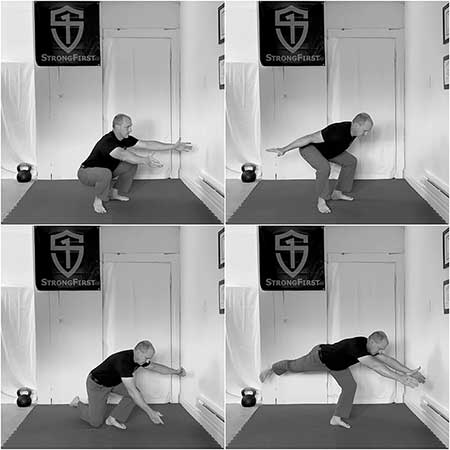
The Debate
I received a response on one of my Instagram posts showing some 40kg one-arm swings that first made me chuckle and then made me think. “Squat more than a hinge…The kettlebell is too heavy for you…Build up to it, you’ll get there.”
The swing is what I define as an athletic hinge, not a squat. So why the confusion or difference of opinions? Believe it or not the definition of what is a squat versus hinge varies and without clarity we will struggle to focus.
To put it in the simplest terms a squat is where the dominant movement of the hips is down, and a hinge is where the dominant movement of the hips is back. Personally, I think this clarity helps define the main difference between the two movements.
To add a bit more to the differences between a squat and a hinge. In a squat the hips will travel down so the crease of the hip is level with or below the top of the knee with a torso that is parallel to or more vertical than the tibias. In a hinge the hips will travel back, and the crease of the hip will remain above the top of the knee and the torso will have a greater angle than the tibia.
But there is an additional wrinkle to the debate: the range of “hinges” that muddies the water. (Not to mention the low bar back squat which is really a hybrid of both.) In fact, if we look at a range of kettlebell drills/skills a continuum of hinges is used. Double kettlebell drills naturally produce a bit more knee bend and dare I say squat since the load dictates the need to counterbalance the pull of the kettlebells in the hinge. In the middle is our preferred athletic hinge that resembles a vertical leap and on the other extreme from the double kettlebell hinge is the Romanian deadlift (RDL) or stiff legged hinge.
Along that continuum are “varieties” of hinging based on body structure. Short torso and long femur versus long torso and short femur for example will result in different hinges, not to mention height and other individual structural variations. So, we can begin to appreciate the confusion a bit especially with the popular “definition” of a hinge being “maximum hip with minimum knee” which blocks you out of many of the hinges on the continuum.
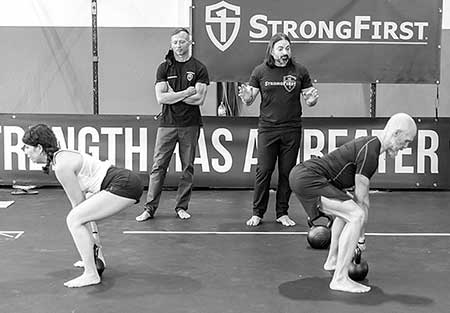
Why?
Why choose one hinge over another? As author Simon Sinek has promoted, the “why” behind something is paramount. Notice that I have not suggested that one hinge is “wrong” and another “right.” There are reasons for each, but I will certainly say that there is one I prefer for most situations.
So why choose one version over the others?
In this study:
The authors investigated the hamstring activity in three different swing styles:
- Hip hinge style—defined as involving slight knee flexion and extension, with minimal ankle motion, thereby exhibiting similar lower body kinematics to a Romanian deadlift.
- Squat style—defined as involving increased range of motion of the ankles and knees, thus resembling a quarter squat and requiring shorter hamstring muscle lengths than the hip hinge style.
- Double knee extension style—defined as not having simultaneous knee and hip extension in both the upward and downward phases. The first knee extension occurs during the downward phase, where the knees extend as the hips flex. The second extension takes place during the upward phase, where the knees and hips extend simultaneously once the kettlebell passes the knees. This exercise is commonly performed by kettlebell sport athletes as an assistance exercise for the kettlebell snatch.
Note that I would argue that the “squat style” (from the article: “The squat swing resembles a motor pattern in commonly used exercises such as a weighted squat or squat jump.”) is what I refer to as an “athletic hinge” and not a squat but since there are no pictures or videos of the swings performed, I cannot confirm this. Also, this study used a 32kg kettlebell while other studies used lighter (16kg) kettlebells, so I think the information is a bit more applicable.
Why would it be important to know hamstring activity in a kettlebell swing? According to the authors, “Examining muscle activity during the different variations of the kettlebell swing seems to be an important step toward understanding the potential role of this exercise in performance training, lower-limb injury prevention, and rehabilitation.”
They continue that since there is other research showing that one- and two-arm swings can provide a training stimulus for the glutes (max and medius), and biceps femoris (BF) but that data for the medial hamstring (MH) was not collected. Identifying the contribution of the BF versus MH is important because more hamstring strains involve the BF, but the MH is potentially important in ACL prevention and rehabilitation.
While the hamstrings all originate from the ischial tuberosity, the biceps femoris travels down the lateral side of the back of leg and attaches to the head of the fibula. And the medial hamstrings, actually two muscles, travel down the medial side of the back of the leg and attach in two different points. The semitendinosus attaches on the pes anserine area of the tibia and the semimembranosus attaches on the medial tibial condyle. The anatomy allows for the function of the hamstrings to flex the knee, extend the hip, and prevent motions like valgus collapse.
Specific Results and Beyond
“The major finding was that during all contraction modes and swings, the MH (medial hamstring) had a significantly greater myoelectrical activity than the BF (biceps femoris). In addition, the hip hinge displayed a significantly greater level of combined myoelectrical activity [of the hamstrings] during the entire repetition when compared with both the squat swing and double knee extension.”
So, what does this mean and are there any other pieces we can dig out?
The greater medial hamstring activity may have implication towards the use of the kettlebell swing in the later stages of ACL rehab and in ACL injury prevention. As the study notes, the medial hamstrings (the semitendinosus in particular) contribution to knee flexion and varus movements, “has been suggested to be the key muscular agonist for reducing the risk of ACL injury.”
Also, “in comparison, the double knee extension requires a fairly unique technique, which has no real resemblance to other commonly used exercises and may be more complex to teach than other kettlebell swings. From a kettlebell sport perspective, as the double knee extension had the lowest hamstring muscle activation across all variables, the [double knee extension] swing may be the preferred choice to use where endurance is required.…”
So, in the end all the swing styles resulted in similar medial hamstring versus biceps femoris activation, but the hip hinge style had higher “overall” activity in the studied musculature.
And the double knee bend style had the lowest overall activation across all variables. Therefore, specific to each style and the results:
- Hip hinge style—the higher overall hamstring activity and the greater medial hamstring activation may make this style a good choice for “targeting” the hamstrings from a general perspective and have applications in hamstring rehab, and ACL rehab. Obviously, this makes perfect sense given what we know and expect of the RDL movement in general as relates to the hamstrings.
- Squat style (athletic hinge)—good overall activity from both the hamstring and medial hamstring, and greater potential carry over to jumping and similar power production movements and exercises. Again, this makes perfect sense given what we know of jumping movements and exercises. This is, by the way, my preferred swing style.
- Double knee extension style—appears to have (as would be expected) more specificity to kettlebell sport and when efficiency/endurance is the goal.
A Caveat and a Note
The caveat: Don’t seek the “stretch.”
Meaning that the reason to choose the hip hinge style should be based on the need to target and strengthen the hamstrings in general and the medial hamstring, not because you feel a “stretch” doing it. Hypermobile folks will tend to choose a style based on feeling a stretch because it is actually the only way they know where they are in a movement due to their hypermobility.
The note: How do you know your hamstrings need strengthening?
If you suspect your hamstrings need strengthening, then you should work with a healthcare professional and/or coach who can set a baseline for your hamstring strength and not only identify the weakness but track the progress of the strengthening.
Final Thoughts
Do you only have one swing?
I know I have been guilty of this. Do you have only one swing or can you choose from different versions like the athletic hinge or RDL? Can you swing to different heights at different “power levels?” Stepping swings, hand to hand swings, and even outside the legs swings…etc., but I think you get my point.
In the end, have a “why” behind your choices. I would choose the RDL style hip hinge to target the hamstrings in a more direct way, the athletic hinge (squat style in the research) for more general athletic transfer and training purposes, and choose the double knee extension style for kettlebell sport applications. Sprinkling in a few RDL style swings within your regular diet of athletic hinges makes good sense and provides good variety to the movement pattern. But I would not use the RDL style exclusively.
As an instructor with just shy of 20 years of experience I can demonstrate a wide variety of swings. But I have not been training a wide variety of swings so it might just be time to expand the repertoire.

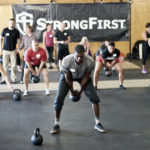
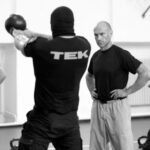
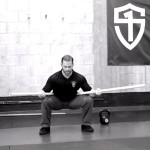





I’ve always referred to Athletic-Hinge Swings as “Pavel Swings” and RDL-Hinge Swings as “Dan John Swings” (like how some people refer to low-bar back squats as “Rippetoe Squats”), mainly because my first exposure to the swing was Pavel’s Enter the Kettlebell DVD more than ten years ago, so I’d always swung with some forward shin-angle and ankle-flexion (bringing my knees roughly over mid-foot) at the bottom, and I didn’t start hearing Dan John’s now widely used definition of “maximal hip-bend with minimal knee-bend” and seeing people’s knees actually moving BACKWARD (I.e., into NEGATIVE shin-angle) on the down portion of their swings until around 2015. I’ve given RDL Swings their fair due of experimentation over the past few years, and while they certainly produce a greater stretch and stimulus for the hamstrings, I learned that I personally prefer just using barbell RDL’s if that’s the purpose. The Athletic-Hinge is the only hinge style I use with kettlebells.
Thank you Billy—the max hip/min knee blocks people out of the athletic hinge IMO and I’ve seen the negative or near negative shins you are referring to and it can be a challenge to get folks to bend their knees enough.
Thank you! This has brought a lot of clarity to a topic that always confused. Especially your classification of the low bar back squat (LBBS). I find that training my LBBS really carries over to other pure squat and other pure hinge type movements.
Thank you Eric—LBBS is really a hybrid lift.